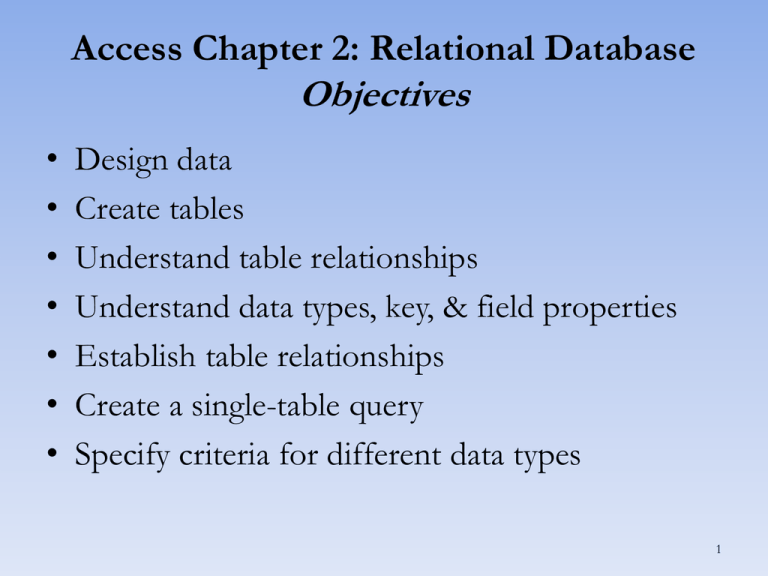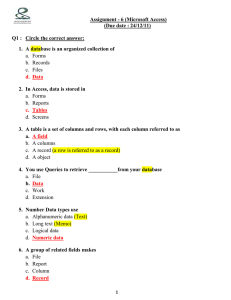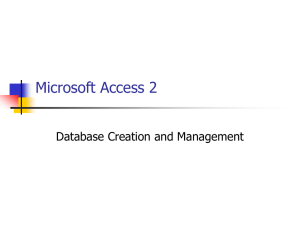Access Chapter 2: Relational Database Objectives
advertisement

Access Chapter 2: Relational Database Objectives • • • • • • • Design data Create tables Understand table relationships Understand data types, key, & field properties Establish table relationships Create a single-table query Specify criteria for different data types 1 Table Design: Designing Data • Table Definition – Revised • Input vs. Output in Design 2 Designing Fields Guidelines 1. 2. 3. 4. 5. 6. Include the necessary data Design for now and the future Store data in its smallest parts Add calculated fields to a table Design to accommodate date arithmetic Link tables using common fields 3 Include Necessary Data • Determine what data is necessary • Create a rough draft of reports that may be needed • Create tables based on fields necessary for reports 4 Design for Now and the Future • Organizations evolve over time • Databases should evolve with the organization – Anticipate future needs of the organization – Build flexibility into system to satisfy future needs 5 Store Data in Smallest Possible Pieces • Creating a name field with the entire name in it violates good database design and reduces the usefulness of the data • Divide data into the smallest pieces that you’re going to need to access – Example: Prefix, FirstName, LastName, Suffix • Provide flexibility for the user 6 Calculated Fields in a Table • Produce a value from an expression or function that references one or more existing fields • Access 2010 allows the user to store calculated fields – Can be a benefit or a potential problem – Exercise caution when using calculated (derived) fields 7 Design to Accommodate Date Arithmetic • Calculated fields can also create date/time data • Plenty of examples available for using date/time date arithmetic 8 Link Tables Using Common Fields • Tables may be joined based on a common field • Join lines are created – Manually by the user, or – Automatically by Access when two fields in separate tables share the same name between two related tables • Avoid Data redundancy errors – The unnecessary storage of duplicate data in two or more tables 9 Creating Tables • Create fields in Design View • Import data from another database or application – Examples: Excel spreadsheets or Word text files • Enter data directly into rows in Datasheet view 10 Creating Fields in Tables • Field names should be meaningful • Rules for naming fields: – Length can be up to 64 characters – Can include letters, numbers and spaces – Access uses CamelCase notation • Use uppercase letters for each first letter of each new word • Example: ProductCost 11 Field Data Types • Every field has a data type • Determines: – The type of data that can be entered – The operations that can be performed on that data • Access recognizes 10 data types 12 Access Data Types • • • • • • Number Text Memo Date/Time Currency Yes/No • • • • OLE AutoNumber Hyperlink Attachment 13 Foreign Key Review A field in one table that is also a primary key of another table SpeakerID is the primary key of the Speakers SpeakerID is the foreign key in the SessionSpeaker table (duplicates are allowed) 14 Using Table Views Datasheet View Active record 15 Using Table Views • Design View • PivotTable • PivotChart 16 Work with Field Properties • • • • • Field property Text data type Number data type Caption property Validation rule 17 Access Field Properties • • • • • • • Field Size Format Input Mask Caption Default Value Validation Rule Validation Text 18 Access Field Properties (continued) • • • • • Required Allow Zero Length Indexed Expression Result Type 19 Understanding Table Relationships • Efficiently combine data from related tables • Create queries, forms, and reports 20 Establishing Referential Integrity • Edit Relationships dialog box • Select Enforce Referential Integrity checkbox 21 Set Cascade Options • Cascade Update Related Fields • Cascade Delete Related Records Click Enforce Referential Integrity Click Cascade Update in case the primary key changes Click Cascade Delete with caution 22 Indexing to Retrieve Data Quickly • Provides quick sorting based on the primary key • Provides quick retrieval of data based on the primary key 23 Options on External Data Tab • • • • Import & Link Export Collect Data Web Linked Lists Click Excel to import spreadsheet data External Data Tab 24 Import Data from Excel Click Browse to find a spreadsheet Decide what you want to do with the data 25 Import Data from Excel (continued) Choose the worksheet to import Preview of the worksheet data Click Next to continue 26 Types of Relationships • One-to-one relationship • One-to-many relationship • Many-to-many relationship 27 Establishing a One-to-Many Relationship • Open Relationships window • Add tables • Establish relationships Show Table window 28 Relationships Between Tables One-to-many relationships Edit Relationships dialog box 29 Relationships Window Join lines Many side: the “” (infinity symbol) 1 side 30 Single-Table Queries • Show Table • Design Grid to add Query Design—Tables – Field row – Table row – Sort row – Show row – Criteria Query Design Grid—Fields, Sorting, and Criteria 31 Datasheet View of Results Query results in Datasheet view Only accounts with a balance over $5,000 Nine records match the criteria 32





